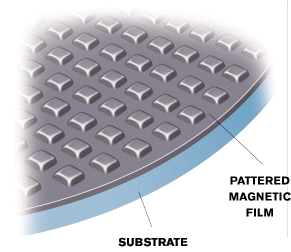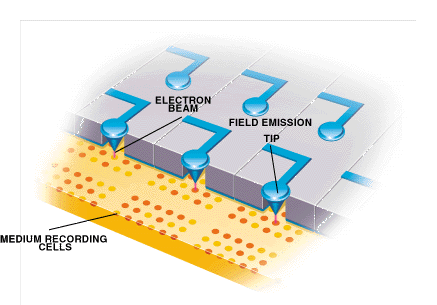The Future (In Brief)
Many technologies are being studied as
possible replacements or substitutes for the storage methods now in use.
Further developments
in Magneto Optical Storage
 |
Magneto-Optical storage using
solid immersion lenses (SIL) is being developed by a company in San Jose
called TeleStor. What the SIL allows is focusing the laser beam on
a much smaller area, allowing much higher data densities.
A note about SIL's: Solid Immersion
Lenses are a special type of truncated spherical lens invented at Stanford
University. SIL's use liquid-immersion microscopy (a magnification
technique), but in reverse, allowing it to focus a laser beam on a spot
smaller than one micron. |
Patterned media

|
Another technology under study
is that of "patterned media." This actually entails creating a surface
with literally billions of small hills or mesas on which bits would be
recorded. This is done to isolate the magnetic fields from one another,
preventing interference from the magnetic patterns of other bits.
While current technologies require 500 to 1000 grains for each bit, a patterned
media disk may only require seven to eight grains per bit. This could
allow up to ten terabits per square inch. Right now, this approach
does not work, because the technology does not exist to create media with
small enough mesas: the need is mesas of eight nanometers; the current
limits of lithographic process is 80 nanometers. |
Holographic Storage
Explaining holographic storage could be
a project in an of itself, in fact, it
is. So, I will attempt to be brief. A holographic crystal
allows data storage in three dimensions, since holograms not only record
light, but it's direction as well. In addition, because holograms
are created using a reference beam to generate an image, several different
data records can be stored in the same location using a slightly different
reference beam. This allows extremely high data densities: the eventual
goal is to enable a data storage of one terabyte (one trillion bytes, or
eight trillion bits) per cubic centimeter. So far, the achievements
to date have garnered 48 megabytes per cubic centimeter. But, this
is encouraging, and research continues. Since trying to go into great
detail would result in a several page addition, I will refer the reader
to this excellent
project, or this
article at the Scientific American.
Atomic Resolution Storage
 |
Atomic resolution storage involves
the actual manipulation of spots as small as a few nanometers across.
The technology, like that of CD-RW, operates on phase changes. To
write data, the field emission tip ejects a stream of electrons, heating
a spot on the recording cell, and changing it to the appropriate phase,
either amphorous or crystalline. Then to read the data, the phase
is check either optically, or by measuring the resistance of the spot.
This technique may allow data densities up to one trillion bits per square
inch. While nowhere close to that of holographic data storage, ARS
could be used where space and power concerns are paramount, such as watches,
phones, or other embedded systems. |
Wow, with all that, we certainly need a
conclusion...


